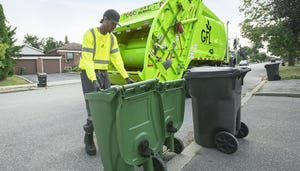No-Text Zone
Waste Management takes on electronic driver distractions.
December 1, 2010
Bill Cole
Technology keeps putting communications devices in our hands, in our ears and on our dashboards. Anyone can reach us, anywhere, at any time, and we're expected to respond immediately, regardless of what we're doing. The National Highway Traffic Safety Administration (NHTSA) quotes a startling fact: More than 800,000 drivers of all vehicles are using a hand-held cell phone at any given moment during daylight hours.
Driver distractions are a known factor in accidents on the road. The more attention required for a task unrelated to driving, the greater the risk. It's more demanding, for example, to locate and insert a CD than to listen to the music it contains, and more distracting to reach into a cooler to get out a sandwich than to eat it. We're used to these traditional tasks, and most fleets have well-established rules clarifying for drivers what is and is not acceptable while behind the wheel. But the multi-tasking made possible by cell phones, texting and hands-free communication devices have put driver distraction back at the top of the agenda for fleets as well as for safety groups and federal and state highway administrators.
Managing the behavior of one driver is a challenge. Doing so consistently with more than 20,000 drivers, as we do at Waste Management, is a mission. Anyone who has ever managed a fleet of any size knows that it takes more than just telling drivers to pay attention and be safe when they leave the yard each day. And, though the expectations created by electronic communication devices up the ante in terms of risk, managing their use is no different than any other safety issue:
Understand the problem.
Create a zero-tolerance policy to confront it.
State expectations clearly.
Train employees to change and maintain safe behavior.
Monitor behavior in the field.
NHTSA, along with other organizations including government agencies and universities, has taken an activist position in addressing the problem of texting and cell phone use behind the wheel. NHTSA divides driver distractions into three main categories: visual — taking your eyes off the road; manual — taking your hands off the wheel; and cognitive — taking your mind off what you're doing.
We've defined the issue for our fleets in similar terms. In our training, we teach our drivers to focus on:
Senses — primarily their vision;
Physical control — expressed primarily through the grip and movement of their hands and the pressure exerted through their feet; and
Intelligent commitment — what's required to interpret what they see and hear, and to coordinate that with their physical control of the vehicle.
The risks are multiplied when using a cell phone, and especially when texting. Both tasks engage all three attention-critical elements — eyes on the cell phone, hands holding the device instead of the wheel, and the driver's focus on the call or the message. The Insurance Institute of Highway Safety found that drivers are four times more likely to be involved in injury accidents when they are using hand-held devices. In 2009, the Department of Transportation (DOT) conducted a study of texting and commercial motor vehicles (CMV) that concluded that texting is the most risky behavior for CMV drivers, making them 23.2 times more likely to get into a "safety-critical event." The DOT study found that "texting drivers took their eyes off the forward roadway for an average of 4.6 seconds during the six-second interval immediately preceding a safety-critical event." That means that moving at 55 mph, the vehicle would travel 371 feet, and at 65 mph would travel 439 feet, before the driver looked back up from the texting device to the road. We all know what can happen in that amount of time.
The framework of Waste Management's cell phone and texting policy is in line with our overall safety policy. Since 2005, the company has reduced OSHA-recordable injuries by 80 percent and improved our vehicle accident rate by 52 percent. The foundation for this turnaround has been a change in culture, driven by our Mission to Zero program. Introduced in 2001, Mission to Zero is a campaign to promote the application of intelligent commitment to driving and equipment operation. The campaign defines safe behavior through continual training, observation and self-evaluation.
Mission to Zero is supported by the company's Driving Science Series (DSS) videos and by the daily safety briefings held at each facility at the start of every shift. The DSS videos are written and produced by our own in-house safety experts and are sent to every operating location along with talking points to be used in safety briefings. Of the 50 DSS videos, 10 address the dangers of driver distraction and ways to manage or eliminate those distractions.
We teach our drivers that 99 percent of their attention should be focused on stimuli outside their vehicle. Our goal is to make these men and women experts in situational awareness — experts who understand environmental influences and the dynamics of vehicle operation. After training, they should be able to translate the science of driving — the hard facts of time, speed and the weight of a heavy-duty vehicle — into safe and responsible behavior. Simply telling drivers more is expected of them because they are professionals will not produce results.
Mission to Zero is not about micromanaging drivers or forcing them to memorize equations for every situation they might encounter. The program affords sufficient discretion and control to the driver to make his own meaningful assessment. By enabling them to identify the consequences of their actions and by defining ethical obligations, our drivers are compelled to behave responsibly when they are behind the wheel. We create specific expectations for responsible behavior.
U.S. Secretary of Transportation Ray LaHood has been waging a fierce public campaign to teach drivers the dangers of phoning and texting behind the wheel. His department's efforts last year resulted in an executive order signed by President Obama banning federal employees from using cell phones in government-owned cars and when in their own vehicles on government business. In January 2010, the Transportation Department issued a rule prohibiting interstate commercial truck and bus drivers from texting while behind the wheel of a moving vehicle.
Likewise, in 2009, Waste Management banned the use of communications devices while operating a moving vehicle for our commercial drivers and for all employees while conducting company business. The ban prohibits the use of cell phones, two-way radios, smart phones, and on-board computers while driving a vehicle or operating a piece of mobile equipment. Before releasing either policy, the company conducted an extensive information campaign to educate employees about the risks of cell phone use while driving and how such a policy fit with the company's overall safety mission. We have included Bluetooth devices in the ban because much of the available data indicates that using hands-free devices does not significantly lessen the risks. Our policy requires drivers to wait until they can safely move out of moving traffic and stop their vehicle before reading, answering or sending any calls or messages.
Though we are expanding the use of on-board computers (OBC) in our operations, our policy prohibits drivers and operators from interacting with their OBC in any way while driving or operating equipment. We have installed a speed limiter in the system that shuts the computer down when the vehicle reaches a certain speed.
Our safety performance metrics indicate that our employees' driving behavior continues to change in a positive way in response to Mission to Zero, the Driver Science Series and our commitment to personal responsibility for safe behavior. And while electronic devices pose a new and significant challenge, they can be managed with the same tools that we use to effectively combat other dangerous driver distractions.
Bill Cole is president of Safety Services for Houston-based Waste Management Inc.
Related Stories
You May Also Like


